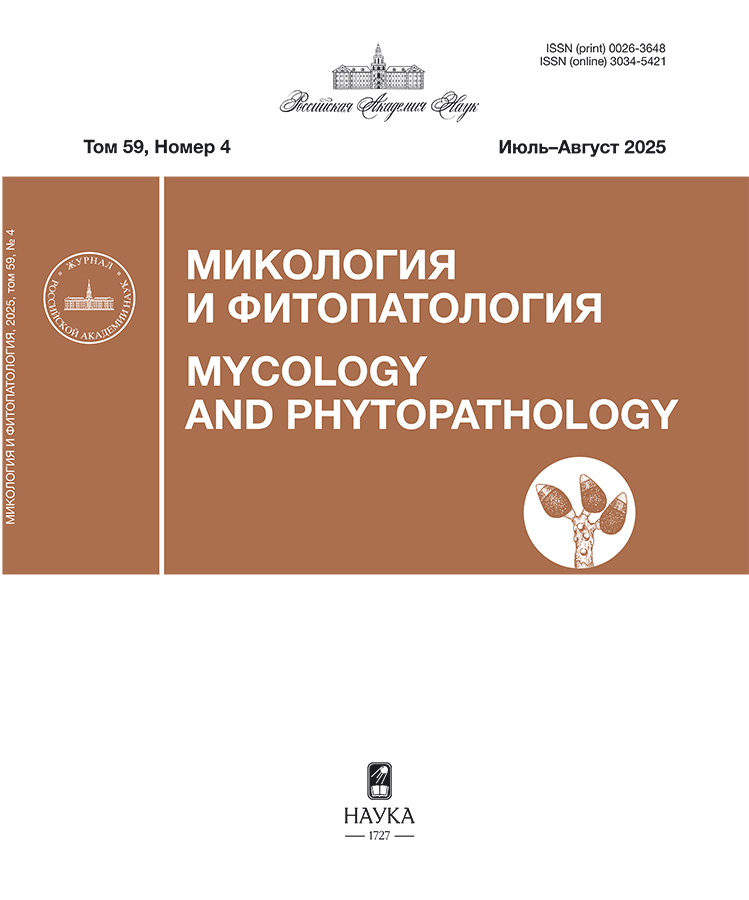Features of the formation of mycobiota of coal mine spoil tips at high latitudes based on metagenomic data
- Autores: Iliushin V.A.1, Kirtsideli I.Y.1
-
Afiliações:
- Komarov Botanical Institute of the Russian Academy of Sciences
- Edição: Volume 59, Nº 4 (2025)
- Páginas: 271–278
- Seção: БИОРАЗНООБРАЗИЕ, СИСТЕМАТИКА, ЭКОЛОГИЯ
- URL: https://bioethicsjournal.ru/0026-3648/article/view/687651
- DOI: https://doi.org/10.31857/S0026364825040013
- EDN: https://elibrary.ru/befwnw
- ID: 687651
Citar
Resumo
The study examines the features of the formation of mycobiota in coal mine spoil tips of different ages using metagenomic data. The purpose is to explore the dynamics of fungi complexes during the succession process in the arctic tundra, southern tundra, and forest-tundra. Samples were taken from coal mine spoil tips in Barentsburg (Svalbard), Vorkuta (Komi Republic), and Susuman (Magadan Region). The results show that the diversity of fungi is mainly represented by Ascomycota. A high proportion of Eurotiomycetes, Dothideomycetes, Leotiomycetes, Agaricomycetes, and Sordariomycetes was found in the chronoseries of the spoil tips. At the genus level, 58 taxa were identified in the Svalbard chronoseries, 59 taxa in the Komi chronoseries, and 65 taxa in the Magadan Region chronoseries. The studies demonstrates that the fungal communities in coal mine spoil tips are diverse and change depending on the age of the tips and the natural zones of the Arctic. It has also been shown that communities of spoil tips within one chronoseries have greater similarities with each other than with communities of spoil tips in other natural zones.
Texto integral
Sobre autores
V. Iliushin
Komarov Botanical Institute of the Russian Academy of Sciences
Autor responsável pela correspondência
Email: ilva94@yandex.ru
Rússia, 197022 St. Petersburg
I. Kirtsideli
Komarov Botanical Institute of the Russian Academy of Sciences
Email: microfungi@mail.ru
Rússia, 197022 St. Petersburg
Bibliografia
- Abakumov E.V. Accumulation and transformation of organic matter in different-aged dumps from sand quarries. Eurasian Soil Sci. 2008. V. 41. P. 844–851. https://doi.org/10.1134/S1064229308080061
- Detheridge A.P., Comont D., Callaghan T.M. et al. Vegetation and edaphic factors influence rapid establishment of distinct fungal communities on former coal-spoil sites. Fungal Ecol. 2018. V. 33. P. 92–103. https://doi.org/10.1016/j.funeco.2018.02.002
- Domsch K.H., Gams W., Anderson T.H. Compendium of soil fungi. IHW-Verlag, Eching, 2007.
- Elhottova D., Kristufek V., Frouz J. et al. Screening for microbial markers in Miocene sediment exposed during open-cast brown coal mining. Antonie Van Leeuwenhoek. 2006. V. 89. P. 459–463.
- Evans H.C. Thermophilous fungi of coal spoil tips. Occurrence, distribution and temperature relationships. Trans. Br. Mycol. Soc. 1971. V. 57. P. 255–266.
- Fungal metagenomic sequencing. demonstrated protocol. 2025. https://support.illumina.com/content/dam/illumina-support/documents/documentation/chemistry_documentation/metagenomic/fungal-metagenomic-demonstrated-protocol-1000000064940-01.pdf. Accessed 10.01.2025.
- Fungal sequencing and classification with the ITS metagenomics protocol. 2018. https://www.illumina.com/content/dam/illumina-marketing/documents/products/appnotes/its-metagenomics-app-note-1270-2018-001-web.pdf. Accessed 10.01.2025.
- Gadd G.M. Metals, minerals and microbes: geomicrobiology and bioremediation. Microbiology. 2010. V. 156. P. 609–643. https://doi.org/10.1099/mic.0.037143-0
- Gräfenhan T., Schroers H.-J., Nirenberg H.I. et al. An overview of the taxonomy, phylogeny, and typification of nectriaceous fungi in Cosmospora, Acremonium, Fusarium, Stilbella, and Volutella. Stud. Mycol. 2011. V. 68. P. 79– 113. https://doi.org/10.3114/sim.2011.68.04
- Hugenholtz P., Goebel B.M., Pace N.R. Impact of culture-independent studies on the emerging phylogenetic view of bacterial diversity. Journal of bacteriology. 1998. V. 180 (18). P. 4765–4774.
- Iliushin V.A. First find of Cadophora antarctica Rodr.-Andrade, Stchigel, Mac Cormack et Cano in the Arctic. Czech Polar Reports. 2020. V. 10 (2). P. 147–152. https://doi.org/10.5817/CPR2020-2-11
- Iliushin V.A., Kirtsideli I.Y. Dynamics of complexes of microscopic fungi in the process of overgrowing spoil tips of coal mines in the southern tundra zone (Komi Republic). Mikologiya i fitopatologiya. 2021. V. 55 (2). P. 129–137. https://doi.org/10.31857/S0026364821020045
- Iliushin V.A., Kirtsideli I.Y., Sazanova N.A. Diversity of microfungi of coal mine spoil tips in the Magadan Region, Russia. Current Research in Environmental and Applied Mycology (Journal of Fungal Biology). 2022b. V. 12 (1). P. 136–146. https://creamjournal.org/pdf/CREAM_12_1_11.pdf
- Iliushin V.A., Kirtsideli I.Y., Vlasov D. Yu. Diversity of culturable microfungi of coal mine spoil tips in Svalbard. Polar Science. 2022a. V. 32. e100793. https://doi.org/10.1016/j.polar.2022.100793
- Ji C., Huang J., Yu H. et al. Do the reclaimed fungal communities succeed toward the original structure in eco-fragile regions of coal mining disturbances? A case study in North China Loess-Aeolian sand area. Front. Microbiol. 2022. V. 13. e770715. https://doi.org/10.3389/fmicb.2022.770715
- Khabibullina F.M., Kuznetsova E.G., Panyukov A.N. Transformation of vegetation, soils, and soil microbiota in the impact zone of the coal mine “Vorkutinskaya”. Theoretical and Applied Ecology. 2015. V. 4. P. 30–37. (In Russ.). https://doi.org/10.25750/1995-4301-2015-4-030-037
- Kompała-Bąba A., Bierza W., Błonska A. et al. Vegetation diversity on coal mine spoil heaps – how important is the texture of the soil substrate? Biologia. 2019. V. 74. P. 419–436. https://doi.org/10.2478/s11756-019-00218-x
- Krause-Jensen D., Duarte C.M. Expansion of vegetated coastal ecosystems in the future Arctic. Front. Mar. Sci. 2014. V. 1. Art. 77. https://doi.org/10.3389/fmars.2014.00077
- Marescotti P., Roccotiello E., Zotti M. et al. Influence of soil mineralogy and chemistry on fungi and plants in a waste-rock dump from the Libiola mine (eastern Liguria, Italy). Periodico di Mineralogia. 2013. V. 82. P. 141–162.
- Quast C., Pruesse E., Yilmaz P. The SILVA ribosomal RNA gene database project: Improved data processing and web-based tools. Nucleic Acids Res. 2013. V. 41. D590–D596. https://doi.org/10.1093/nar/gks1219
- Ruiz-Jaen M.C., Mitchell Aide T. Restoration success: how is it being measured? Restor. Ecol. 2005. V. 13. P. 569–577. https://doi.org/10.1111/j.1526-100X.2005.00072.x
- Sazanova K.V., Zelenskaya M.S., Vlasov A.D. et al. Microorganisms in superficial deposits on the stone monuments in Saint Petersburg. Microorganisms. 2022. V. 10. P. 316. https://doi.org/10.3390/microorganisms10020316
- Stevens J. Applied multivariate statistics for the social sciences. Erlbaum, Hillsdale, 1986.
- Ulfig K., Korcz M. Isolation of keratinolytic fungi from a coal mine dump. Mycopathologia. 1995. V. 129. P. 83–86. https://doi.org/10.1007/BF01103466
- Vlasov D.Y., Abakumov E.V., Nadporozhskaya M.A. et al. Lithosols of king george island, western Antarctica. Eurasian Soil Sci. 2005. V. 38. P. 681–687.
- Wise D.L. Bioprocessing and biotreatment of coal. Marcel Dekker, N.Y., 1990.
- Хабибуллина Ф.М., Кузнецова Е.Г., Панюков А.Н. (Khabi-bullina et al.) Трансформация растительности, почв и почвенной микробиоты в зоне воздействия породных отвалов угольной шахты “Воркутинская” // Теоретическая и прикладная экология. 2015. № 4. С. 30–37.
Arquivos suplementares











